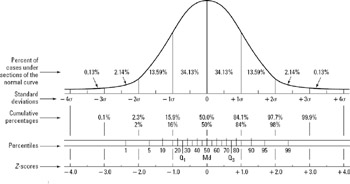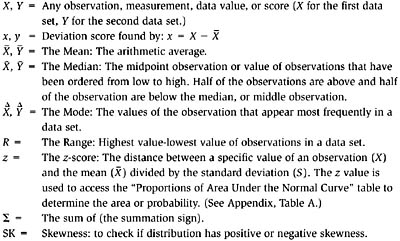Tool 66: Descriptive Statistics
| AKA | N/A |
| Classification | Planning/Presenting (PP) |
Tool description
Descriptive statistics are the procedure used to organize, summarize, and describe data that were collected over time or as a result of a data collection process during a research project. The statistical calculations provide measures of central tendency and measures of dispersion, which are often used as supporting information in the decision-making process.
Typical application
-
To summarize research data into meaningful forms using standard statistical techniques.
-
To describe, in statistical terms, collected data for reporting purposes.
-
To use statistical data to improve the decision-making process.
Problem-solving phase
| Select and define problem or opportunity | |
| Identify and analyze causes or potential change | |
| Develop and plan possible solutions or change | |
| → | Implement and evaluate solution or change |
| → | Measure and report solution or change results |
| Recognize and reward team efforts |
Typically used by
| 1 | Research/statistics |
| Creativity/innovation | |
| 2 | Engineering |
| 3 | Project management |
| 4 | Manufacturing |
| Marketing/sales | |
| Administration/documentation | |
| Servicing/support | |
| Customer/quality metrics | |
| Change management |
before
-
Data Collection Strategy
-
Sampling Method
-
Random Numbers Generator
-
Standard Deviation
-
Frequency Distribution (FD)
after
-
Process Capability Ratios
-
Control Chart
-
Correlation Analysis
-
Analysis of Variance
-
Hypothesis Testing (Chi-Square)
Notes and key points
The normal probability distribution is a symmetrical, bell-shaped distribution frequently used in statistical analyses. The arithmetic mean ( ) median (
) median (![]() ) and mode (
) and mode (![]() ) are of equal value and are located at the center and peak of the curve. These measures are averages and therefore considered measures of central tendency. Measures of dispersion are measures under the curve, moving horizontally left or right to identify area or probability. Among others, standard deviations (S), z-values (z), and percentiles (%) are most often used in descriptive and inferential statistics.
) are of equal value and are located at the center and peak of the curve. These measures are averages and therefore considered measures of central tendency. Measures of dispersion are measures under the curve, moving horizontally left or right to identify area or probability. Among others, standard deviations (S), z-values (z), and percentiles (%) are most often used in descriptive and inferential statistics.

Symbols and Definitions:
| Population | Sample |
| N = Population size | n = Sample size |
| μ = Population mean | |
| σ2 = Population variance | S2 = Sample variance |
| σ = Population standard deviation | S = Sample standard deviation |
Variance: σ2 (sigma squared) is the average of the squared deviation scores (x) of the observations from the mean (![]() ).
).
Standard deviation: σ (Sigma) is the square root of the average of the squared deviation scores (x) of the observations from the mean (![]() ).
).
Deviation scores: (x) Found by subtracting the mean (![]() ) from each observation or data value.
) from each observation or data value.
X, Y = Any observation, measurement, data value, or score (X for the first data set, Y for the second data set.)
x, y = Deviation score found by: x = X − 
 = The Mean: The arithmetic average.
= The Mean: The arithmetic average.
![]() = The Median: The midpoint observation or value of observations that have been ordered from low to high. Half of the observations are above and half of the observation are below the median, or middle observation.
= The Median: The midpoint observation or value of observations that have been ordered from low to high. Half of the observations are above and half of the observation are below the median, or middle observation.
![]() = The Mode: The values of the observation that appear most frequently in a data set.
= The Mode: The values of the observation that appear most frequently in a data set.
R = The Range: Highest value-lowest value of observations in a data set.
Z = The z-score: The distance between a specific value of an observation (X) and the mean (![]() ) divided by the standard deviation (S). The z value is used to access the "Proportions of Area Under the Normal Curve" table to determine the area or probability. (See Appendix, Table A.)
) divided by the standard deviation (S). The z value is used to access the "Proportions of Area Under the Normal Curve" table to determine the area or probability. (See Appendix, Table A.)
Σ = The sum of (the summation sign).
SK = Skewness: to check if distribution has positive or negative skewness.
Equations:

| Note | n−1 is used when total observations = ≤30. |
Step-by-step procedure
-
STEP 1 The raw data are organized by sorting, sequencing, grouping, or placing them into matrices or tables.
-
STEP 2 Basic measures of central tendency, measures of dispersion, and z-scores to percentiles under the normal probability curve can now be calculated. See example Document Wire Extension Measurement.
-
STEP 3 All calculations are checked and used in reports or presentations as supporting information.
Example of tool application
Document Wire Extension Measurements
Refer to #8 (notes and key points) for the equations used below.


-
Refer to "Percentage of Area Under the Normal Curve" in Table A of the Appendix to check percentage (%); also described in "Normal Probability Distribution" in this book.
EAN: 2147483647
Pages: 326